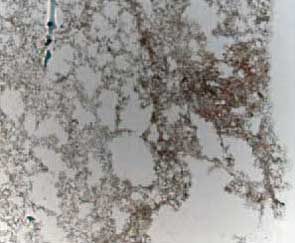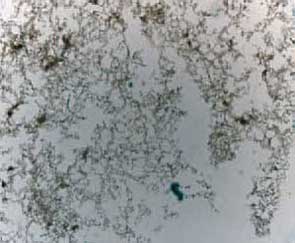| Posted: Jul 27, 2007 | |
Inhaling bubbles to fight lung cancer |
|
| (Nanowerk Spotlight) Inhalation, or respiratory, therapy is a fairly old discipline of medicine that dates back to ancient times (and not always for purely therapeutic effects; witness the hookah). In the late 18th century, earthenware inhalers became popular for the inhalation of air drawn through infusions of plants and other ingredients and about 50 years ago the first pressurized metered dose inhaler was put on the market. Especially people suffering from asthma are very familiar with inhalers - devices that help deliver a specific amount of medication to the lungs. The delivery of drugs via the pulmonary route is a potentially effective form of therapy not only for asthma but also for for patients with other chronic diseases, including the debilitating hereditary disease, cystic fibrosis, type I diabetes (insulin is absorbed well through the lungs), and recently lung cancer. During inhalation therapy the drugs are delivered in aerosol form, meaning that very small particles of the drug are suspended in air (liquid particles make mist, solid particles make fume or dust). Unfortunately, state the-of-the-art aerosol delivery technologies do not allow to target aerosols to specific regions of the lung. Researchers in Germany now have show that aerosols containing magnetic nanoparticles can be guided inside the lungs and thus offer a potential new route for lung cancer treatment. | |
| Current aerosol delivery techniques only allow to target aerosol deposition in the central lung regions or lung periphery but not focused to desired lung regions. A new research effort by German researchers was designed to provide a potentially new technology to close this gap and to offer potentially more gentle treatment options for patients suffering from severe lung diseases such as lung cancer. At first glance it might seem weird that lung cancer, which very often is caused by inhaling carcinogenic particles found in polluted air and tobacco smoke, can be treated by just inhaling some more particles. Although aerosol therapy does work to some degree (" Aerosol Therapy for Malignancy Involving the Lungs"), as with all other current cancer drug therapies there are side effects caused by the administered drugs' damage to healthy tissue. | |
| "Being able to target specific areas in the lung with cancer drug aerosols would avoid potential drug-related site effects in healthy tissue" Dr. Carsten Rudolph explains to Nanowerk. "We were able to demonstrate theoretically by computer-aided simulation and for the first time experimentally in mice, that targeted aerosol delivery to the lung can be achieved with aerosol droplets comprising superparamagnetic iron oxide nanoparticles (SPIONs), so-called nanomagnetosols, in combination with a target-directed magnetic gradient field." | |
| Rudolph, together with colleagues from various universities in Munich and Berlin, and other institutions across Germany, shows that with their technique, higher doses of drugs can be delivered to the cancerous region without increasing side effects ("Targeted delivery of magnetic aerosol droplets to the lung"). | |
  |
|
| SPION deposition (brown color) in the lungs. Left: with magnetic field. Right: without magnetic field. (Reprinted with permission from Nature Publishing Group) | |
| The German research team suggests that nanomagnetosols may advance the field towards a patient tailor-made aerosol treatment, e.g. for treating localized lung diseases, such as foci of bacterial infection or tumor nodules. | |
| Rudolph explains how in traditional aerosol therapy the inhaled particles are carried through the respiratory tract with tidal air and deposit in the lungs when their trajectories differ from the inspired air stream. This difference is induced by forces such as gravity and impulse transfer from gas molecules acting on the particles, and inertia. | |
| Although it has previously been demonstrated ("Magnetic targeting of aerosol particles for cancer therapy") that aerosol deposition can be magnetically targeted in vitro, these particles, owing to their size and small magnetic momentum, could not be moved easily. | |
| The novel aspect in the German researchers' work is that they assembled a multitude of SPIONs into microdroplets, so-called nanomagnetosols, which led to an increased magnetic moment. This resulted in aerosols guidable by technically feasible and medically compatible magnetic fields. By including one or several drugs inside the aerosol droplets, these nanomagnetosols become guided drug delivery vehicles. | |
| In medical practice, drug dosing will be as high as required to secure an effective drug level at the target site, unless side effects become unacceptable. This, however, is quite frequently the case. | |
| "To reduce deposition in the untargeted lung lobe, we suggest, based on our calculations, the positioning of a bypass magnet close to the main bifurcation of the trachea" says Rudolph. "Our calculations suggest that this is a realistic scenario." | |
| "The challenge of the technology will be to scale up the appropriate conditions from mice to human patients" says Rudolph. "For instance, the nonlinear fall in magnetic force with distance is a significant issue. When we positioned the magnetic tip 1 mm above the lung lobe, the relative SPION concentration was eightfold higher than in a lung lobe not exposed to a magnetic field. When we moved the tip away to 2 mm we observed a much reduced relative accumulation only 2.5-fold higher. This will be an issue with human patients, where the magnetic field has to penetrate a much larger distance. Scaling up the magnetic gradient field to address the size of the human lung represents the major challenge in translating this technology to humans." | |
 By
Michael
Berger
– Michael is author of three books by the Royal Society of Chemistry:
Nano-Society: Pushing the Boundaries of Technology,
Nanotechnology: The Future is Tiny, and
Nanoengineering: The Skills and Tools Making Technology Invisible
Copyright ©
Nanowerk LLC
By
Michael
Berger
– Michael is author of three books by the Royal Society of Chemistry:
Nano-Society: Pushing the Boundaries of Technology,
Nanotechnology: The Future is Tiny, and
Nanoengineering: The Skills and Tools Making Technology Invisible
Copyright ©
Nanowerk LLC
|
|
Become a Spotlight guest author! Join our large and growing group of guest contributors. Have you just published a scientific paper or have other exciting developments to share with the nanotechnology community? Here is how to publish on nanowerk.com.
